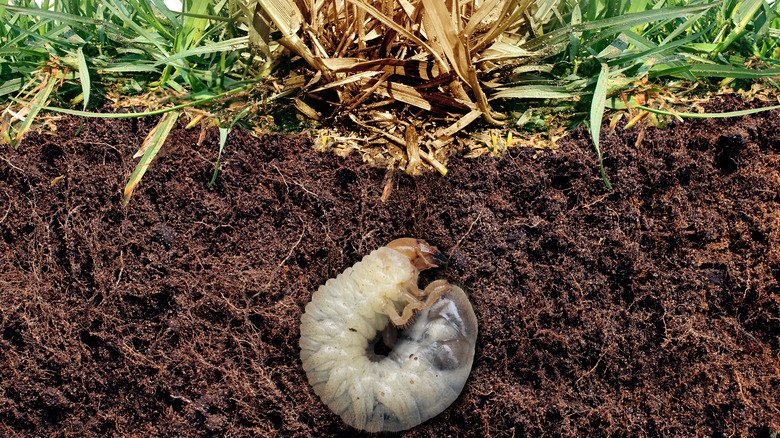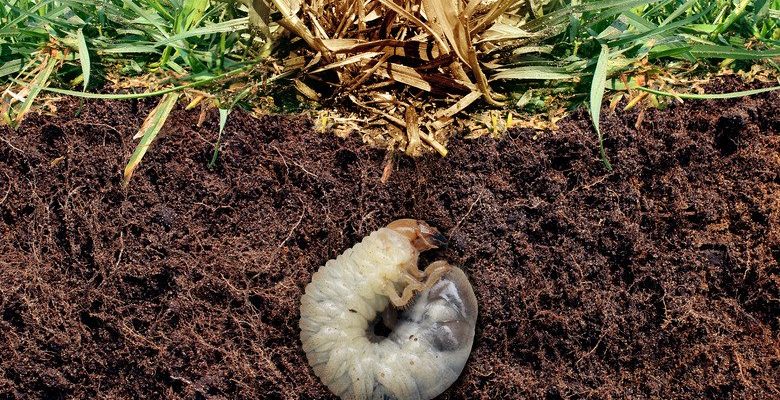
Grub worms, the larval stage of beetles like Japanese beetles, can wreak havoc on your lawn if left unchecked. They thrive in the warm, moist soil beneath your grass, feasting on roots and leading to dead patches that can ruin your lawn’s beauty. Recognizing the early signs of grub worms can save you from a lawn disaster. This guide will walk you through what to look out for, how to identify them, and what steps you can take to kick them out—kind of like that unwanted guest who overstays their welcome.
What Are Grub Worms?
Grub worms are the larvae of various beetles. They usually range from a half-inch to an inch long and have a C-shaped appearance. These little critters spend most of their lives underground in the soil beneath our lawns, where they feast on grass roots, which can lead to serious lawn damage. Picture them as tiny lawn ninjas—stealthy and destructive, working quietly under your sod while you enjoy the surface view.
Their life cycle is fascinating. Adult beetles lay eggs in late summer, and those eggs hatch into grub worms. They feed on roots throughout the fall and can cause significant damage. If you’re noticing declining health in your lawn, these grubs could be the culprits.
Early Signs of Grub Worm Infestation
You might be wondering, “How do I know if I have grub worms?” Well, there are a few telltale signs to watch for. One of the first indicators is the appearance of patches of brown grass. These areas often feel spongy when you step on them, almost like walking on a bouncy castle. Grass becomes weak and can easily be pulled up, revealing those pesky grubs underneath.
Another sign is an increase in activity from birds or animals. If you notice more birds pecking at your lawn or animals like raccoons or skunks digging up your sod, they might be after the grubs. It’s like they’re throwing a feast, and your lawn is the buffet table!
How to Spot Grub Worms
To confirm a suspicion of grub worms, it’s time for a little detective work. You want to check your lawn in the evening or early morning when the grubs are closer to the surface. Grab a small shovel or garden spade and dig up a patch of sod about one foot by one foot. Gently lift it and check underneath. If you see a handful of white, C-shaped grubs, you’ve got a problem.
Another method is the soap test. Mix a few tablespoons of dish soap with water and pour it over a patch of your lawn. The soap irritates the grubs, causing them to rise to the surface. Just remember that if you don’t see any grubs initially, it doesn’t mean you’re in the clear. Grub populations can fluctuate, so regular checks are essential.
What Damage Do Grub Worms Cause?
Grub worms can do significant damage to your lawn. They feed on the roots of grass, which starves the plants of nutrients and water. Over time, this leads to those dreaded brown patches and even dead areas in your lawn. Honestly, it’s pretty alarming to see your once lush green space turn into a sad, patchy mess.
They can also attract pests. As the grubs damage your lawn, it can weaken your soil structure and make it more susceptible to other diseases. It’s like a domino effect—one problem leads to another—until you’re facing a lawn crisis.
Preventing Grub Worm Infestations
Prevention is key when it comes to keeping grub worms at bay. One effective way is to maintain a healthy lawn. Regular watering, mowing, and aeration help strengthen grass roots, making them less appealing to grubs. Think of it as fortifying your castle walls; the stronger your defenses, the less likely invaders will cause trouble.
Another tactic is to attract beneficial insects like nematodes. These tiny guys feed on grubs and can help control their population naturally. You might even consider using organic insecticides as part of an integrated pest management approach. Just remember to follow the instructions carefully; you don’t want to harm non-target species or the environment.
How to Get Rid of Grub Worms
If you’ve discovered that your lawn is already infested, don’t panic. There are several methods to tackle the problem effectively. Chemical treatments are widely available and can be very effective if applied correctly. Look for products that contain ingredients like imidacloprid or chlorantraniliprole. Always read the label and follow instructions to ensure safety and proper application.
If you prefer a more natural approach, you can apply nematodes or beneficial nematodes, which are microscopic worms that feed on grubs. They’re usually applied in the evening when temperatures are cooler, to ensure they don’t dry out. It takes a bit longer to see results using this method, but it’s a great way to maintain a healthy ecosystem in your lawn.
When to Seek Professional Help
Sometimes, despite your best efforts, you may realize that your lawn has become a battlefield, and you might need to call in the professionals. If the infestation is severe or if you’re unsure about how to proceed, lawn care experts can assess the situation and recommend a tailored treatment plan. They have access to specific tools and products that can quickly address the problem while minimizing damage to your grass.
Remember, recognizing the signs of grub worms early can save you time and effort in the long run. Regular checks and maintaining a healthy lawn are your best defenses against these unwanted intruders.
In conclusion, grub worms can be a pesky issue for any lawn owner, but with the right knowledge and a bit of vigilance, you can keep your yard healthy and beautiful. Watch for those signs, take preventive measures, and don’t hesitate to take action when needed. Your lawn deserves it!

